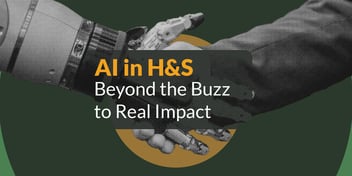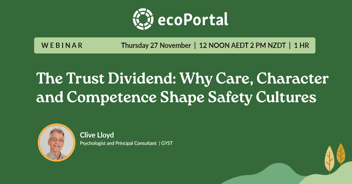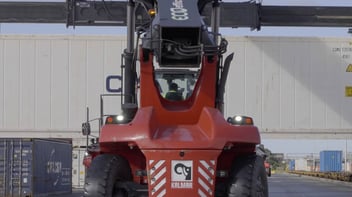As we reflect on the World Day for Safety and Health at Work, it’s worth considering how far we’ve come—and where we’re heading.
In an age where workplace risk management is more critical than ever, Artificial Intelligence (AI) is emerging as a powerful enabler. Across industries, AI is no longer seen as a distant concept; it’s being recognised as a practical tool with real, tangible benefits.
Its integration into Health and Safety operations is reshaping how teams engage with safety processes, unlocking new levels of insight, efficiency, and shared responsibility.
And yet, a recent Verdantix Corporate Survey (2024) reveals that 49% of organisations cite “a lack of success stories in their industry” as a reason for delayed AI adoption. This tells me there’s still a clear need for more awareness—and more leadership.
Get fresh H&S insights weekly
Engagement: The Key to a Safe Workplace
Over the past 15 years, I’ve had the privilege of speaking with Health and Safety leaders across the globe. One concern comes up time and again: a lack of engagement is stalling progress toward stronger safety cultures.
Without meaningful engagement, safety risks devolve into a compliance exercise, becoming reactive rather than proactive. Worse still, the burden of safety often falls solely on H&S professionals, sidelining the very people who are best placed to create change—the frontline.
The truth is: you don’t need to be a data scientist or a technology guru to use AI to create a safer workplace.
True safety cultures thrive when responsibility is shared. When team leaders become the first line of support, we see real progress that includes:
- Improved connectivity across teams
- Increased near-miss reporting
- Reduced number of safety incidents
- Fewer serious injuries and fatalities (SIFs)
- Greater productivity
- Higher job satisfaction
- Lower employee turnover
- Increased safety knowledge
(Source: Verdantix, Best Practices: Building Safety Engagement Through Technology, 2023)
These benefits are not just ideal outcomes—they are increasingly achievable when we put the right tools in place.
Where Does AI's Potential Lie?
When it comes to Health and Safety, where does AI’s greatest potential truly lie—and why?
AI’s real strength is in breaking down the traditional barriers to engagement and decision-making. Its impact becomes most evident when it’s applied directly to the challenges that have long hindered safety outcomes:
- Breaking Down Engagement Barriers – Removing literacy, language, and complexity hurdles to make participation easier and more inclusive for every worker.
- Smart Data Capture – Leveraging tools like voice-to-text, image recognition, and form assistance to enable fast, effortless reporting straight from the field.
- AI-Driven Safety Insights – Summarising key findings, reducing admin burden, and delivering real-time insights to support faster, more informed decisions.
- Smarter Compliance & Guidance – Offering instant, context-sensitive guidance to help teams meet regulatory requirements with confidence.
- AI-Powered Video Analysis – Using computer vision to detect hazards, unsafe behaviours, and near misses in real time—helping organisations move from reactive to proactive safety management.
But here’s the reality: AI cannot replace a strong Health and Safety foundation. Technology alone can’t fix a weak safety culture.
Without that foundation in place, even the smartest AI tools risk becoming underutilised—or worse, ineffective.
How Do We Address It?
We have to remember: AI should enhance, not replace, human-led safety initiatives.
It must complement—and never operate in a silo from—existing Health and Safety management systems.
To make AI successful, we must first build proactive safety cultures. When we do that, AI becomes a powerful ally that supports existing processes—not a “quick fix.”
AI in Action: From Complexity to Clarity
At ecoPortal, we’re already seeing the real-world impact of AI.
Take, for example, a use case from one of our customers: a warehouse team leader for a major grocery organisation.
When a near-miss occurs, it's their responsibility to investigate the incident. Traditionally, this would mean sifting through pages of documentation.
But with an AI-powered summary in ecoPortal, the team leader receives a clear overview of key details—who was involved, what happened, what equipment was used, and what immediate actions were taken.
When faced with a regulatory question—“Is this event notifiable?”—our system provides location-specific guidance, ensuring compliance and building her confidence. This not only decentralises safety responsibilities but empowers non-experts to make informed decisions.
The same dynamic plays out at the management level. A Health and Safety Manager receives a comprehensive AI-generated report summary, including causes, outcomes, and related hazards.
With a simple query—“Why did this take so long to close out?”—AI identifies bottlenecks and even recommends ways to speed up future investigations.
This isn’t just about efficiency. It’s about freeing up time for safety leaders to focus on what drives meaningful impact—engaging teams, strengthening culture, and preventing incidents before they happen.
Real-World Success: AI as an Educational and Design Tool
Organisations are already putting AI to work in creative and impactful ways.
Using AI-powered video analysis, they can educate workers on real-world risks—not as a disciplinary measure, but as a proactive learning tool.
It helps close the gap between “work as imagined” and “work as done,” enabling better work design and stronger controls.
This shift reflects one of our core beliefs at ecoPortal: education works better than punishment.
Building awareness through smart tools fosters ownership, collaboration, and ultimately, safer behaviours.
Why Now? The Era of Engagement
Looking ahead, it’s the right time to ask:
What does engagement really look like in 2025?
It looks like organisations embracing AI not for its novelty, but for its ability to strengthen culture, reduce risk, and support every worker—from the frontline to the boardroom.
The benefits are clear:
- Greater connectivity across teams
- Higher engagement and ownership
- Increased safety knowledge
- Smarter, faster decision-making
And most importantly, AI helps embed safety deeper into an organisation’s DNA—where leaders lead, teams take responsibility, and safety becomes a shared language.
What We Learned: AI's Growing Role in Building Safer Workplaces
Following our recent webinar, AI-Powered Risk Intelligence: Smarter Insights, Safer Workplaces, it’s even clearer how AI is already reshaping the future of Health and Safety.
Led by guest speaker Liz Hancock, Director of HSE at DCC Technology, the session brought forward practical insights grounded in day-to-day H&S operations.
One standout example? How AI is dramatically reducing the time and effort needed to produce complex safety documentation. Tasks like drafting a tender request—once a multi-day job—can now be turned around in hours with the help of AI-powered tools.
We also explored how AI is accelerating the development of training materials. While full automation of immersive VR modules is still on the horizon, AI is already capable of generating quality first drafts for toolbox talks, safe work procedures, and site-specific inductions—giving H&S leaders more time to focus on tailoring and delivery.
But the biggest takeaway was this: AI’s value lies not in replacing human expertise, but in amplifying it.
As Liz highlighted, no algorithm can replicate the intuition and situational awareness of someone on the ground. The future of safety is built on the connection between smart systems and experienced people.
If you want to dive deeper into the insights shared, you can watch the full session here:
Looking Ahead: A Smarter, Safer Future
AI may not have all the answers, but like a trusted colleague, it offers perspective, guidance, and fresh thinking. As the adage goes, two heads are better than one—and with AI in the mix, Health and Safety professionals gain a powerful partner.
For those still waiting for industry proof points, here’s my message: the success stories are already happening. Organisations using AI today are seeing stronger engagement, better outcomes, and more efficient operations.
At ecoPortal, we’re proud to be helping global customers embed AI into their EHS systems and build safer, smarter workplaces—together.
Let’s continue to celebrate innovation that empowers people. Let’s choose tools that elevate engagement and move from compliance to culture—one insight at a time.





.png?width=352&name=Blog%20hero%20image%202406%20(4).png)
.png?width=352&name=Verdantix%20GQ%20Blog%20(4).png)
tal%20health.png?width=352&name=Lets%20talk%20(men)tal%20health.png)


